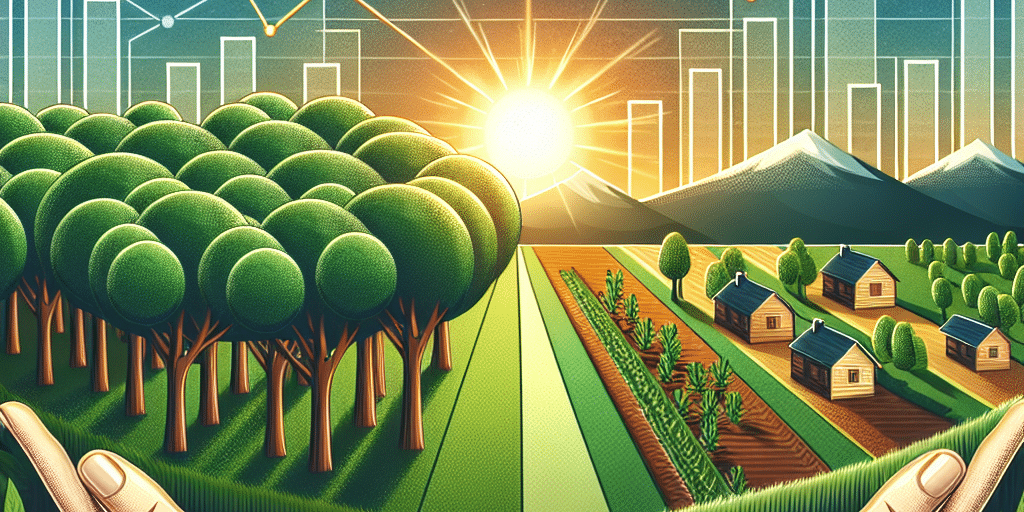In an era marked by economic uncertainty and fluctuating markets, investors are increasingly seeking reliable and tangible assets to secure their financial future. Among various asset classes, timber and farmland have emerged as two of the most stable and lucrative long-term investments. With their unique characteristics and multitude of benefits, these traditional holdings are capturing the interest of savvy investors looking to grow their wealth sustainably.
The Case for Timber Investment
1. Appreciation and Yield
Timberland has long been recognized for its potential to appreciate over time. As trees grow, they increase in value, and the demand for timber is consistently high due to its widespread applications in construction, furniture, and various industries. Landowners can capitalize on this growth by selectively harvesting timber, generating significant cash flow while maintaining the value of the land.
2. Inflation Hedge
In times of inflation, timber often serves as a powerful hedge. As consumer prices rise, so does the cost of goods that rely on timber, including lumber and paper products. This dynamic ensures that timber investments tend to retain and even increase their real value over time, making it a sound choice during uncertain economic climates.
3. Environmental Sustainability
Timber investment also contributes positively to the environment. Sustainable forestry practices allow for the maintenance of healthy forests, which in turn offer important ecological benefits, such as carbon sequestration and biodiversity conservation. This growing focus on environmental sustainability aligns with the increasing consumer preference for environmentally responsible investments.
4. Low Correlation to Market Volatility
Timber markets often demonstrate a low correlation with stock market performance. This characteristic provides a level of portfolio diversification that can mitigate risk, making timber a valuable addition to traditional investment strategies focused on equities and bonds.
The Benefits of Farmland Investment
1. Stable Revenue
Farmland consistently produces income from agricultural products, providing a steady cash flow for investors. As global populations grow and the demand for food increases, farmland assets are poised for stable appreciation. Lover crop prices are often offset by the increasing demand for food, while optimal conditions and sustainable practices can enhance yields over time.
2. Tax Advantages
Investing in farmland can come with several tax benefits. In many jurisdictions, agricultural landowners enjoy favorable property tax assessments, and certain funding programs may provide additional tax incentives for responsible land use and conservation.
3. Biodiversity and Ecological Benefits
Just as with timber, investments in farmland also promote ecological health. Sustainable agricultural practices preserve the land and biodiversity, ensuring it can be passed down through generations. Investing in farmland not only secures financial returns but also contributes to food security and the planet’s health.
4. Direct Control and Value Addition
Investors in farmland have the unique opportunity to directly influence their returns through active management. Implementing advanced agricultural techniques, crop rotation, or transitioning to organic farming can increase yields and land value. This degree of control over an investment is often not available in more traditional asset classes.
Risks and Considerations
While timber and farmland offer numerous advantages, potential investors should be aware of certain risks associated with these investments. Factors such as climate change, regulatory changes, and market demand fluctuations can impact profitability. Additionally, these assets require significant initial capital and, in some cases, specialized knowledge for effective management. Thus, conducting thorough research and engaging with industry experts is crucial before pursuing these opportunities.
Conclusion: A Sustainable Investment for the Future
As economic volatility continues to pose challenges in traditional markets, timber and farmland investments present rational alternatives with inherent strengths that traditional stocks or bonds cannot match. Their potential for steady appreciation, cash flow, and positive environmental impact makes them compelling long-term investments. With careful consideration and strategic management, timber and farmland could provide both financial returns and a contribution to global sustainability, appealing to both seasoned and novice investors alike. As we look to the future, investing in these green goldmines may very well be a path toward financial growth and environmental stewardship.










